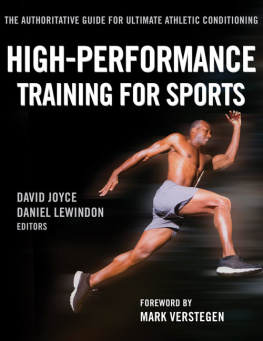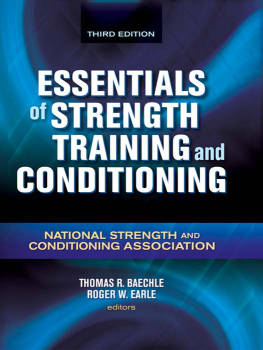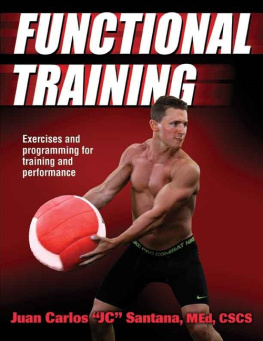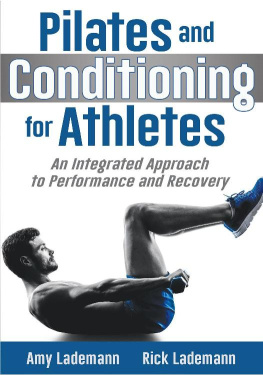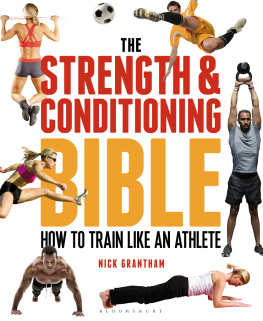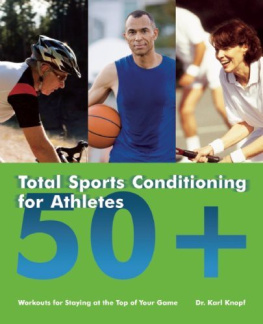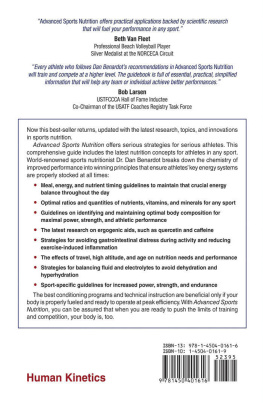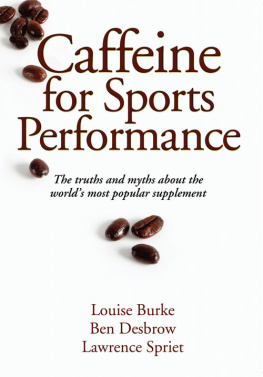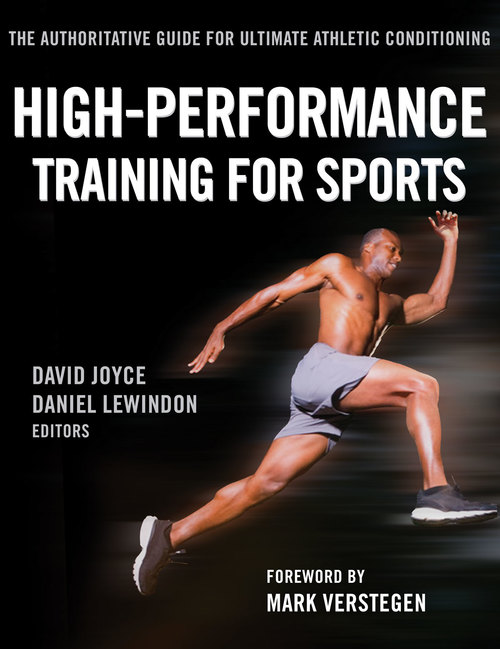
Library of Congress Cataloging-in-Publication Data
High-performance training for sports / David Joyce, Daniel Lewindon, editors.
pages cm.
Includes bibliographical references and index.
1. Sports--Physiological aspects. 2. Physical education and training. I. Joyce, David, 1976
RC1235.H54 2014
613.7'11--dc23
2013042014
ISBN-10: 1-4504-4482-2 (print)
ISBN-13: 978-1-4504-4482-8 (print)
Copyright 2014 by David Joyce and Dan Lewindon
All rights reserved. Except for use in a review, the reproduction or utilization of this work in any form or by any electronic, mechanical, or other means, now known or hereafter invented, including xerography, photocopying, and recording, and in any information storage and retrieval system, is forbidden without the written permission of the publisher.
This publication is written and published to provide accurate and authoritative information relevant to the subject matter presented. It is published and sold with the understanding that the author and publisher are not engaged in rendering legal, medical, or other professional services by reason of their authorship or publication of this work. If medical or other expert assistance is required, the services of a competent professional person should be sought.
The web addresses cited in this text were current as of February 2014, unless otherwise noted.
Associate Acquisitions Editor: Chris Wright
Developmental Editor: Cynthia McEntire
Managing Editor: Elizabeth Evans
Copyeditor: Ann Prisland
Indexer: Nan N. Badgett
Permissions Manager: Martha Gullo
Graphic Designer: Francine Hamerski
Cover Designer: Jonathan Kay
Photograph (cover): Image Source / Aurora Photos
Photographs (interior): Human Kinetics, unless otherwise noted
Photo Asset Manager: Laura Fitch
Visual Production Assistant: Joyce Brumfield
Photo Production Manager: Jason Allen
Art Manager: Kelly Hendren
Associate Art Manager: Alan L. Wilborn
Illustrations: Human Kinetics, unless otherwise noted
Printer: Premier Print Group
We thank Rugby WA in Floreat, Western Australia, and Edith Cowan University in Joondalup, Western Australia, for assistance in providing the location for the photo shoot for this book.
Human Kinetics books are available at special discounts for bulk purchase. Special editions or book excerpts can also be created to specification. For details, contact the Special Sales Manager at Human Kinetics.
Printed in the United States of America
10 9 8 7 6 5 4 3 2 1
Website: www.HumanKinetics.com
United States: Human Kinetics
P.O. Box 5076
Champaign, IL 61825-5076
800-747-4457
e-mail: humank@hkusa.com
Canada: Human Kinetics
475 Devonshire Road Unit 100
Windsor, ON N8Y 2L5
800-465-7301 (in Canada only)
e-mail: info@hkcanada.com
Europe: Human Kinetics
107 Bradford Road
Stanningley
Leeds LS28 6AT, United Kingdom
+44 (0) 113 255 5665
e-mail: hk@hkeurope.com
Australia: Human Kinetics
57A Price Avenue
Lower Mitcham, South Australia 5062
08 8372 0999
e-mail: info@hkaustralia.com
New Zealand: Human Kinetics
P.O. Box 80
Torrens Park, South Australia 5062
0800 222 062
e-mail: info@hknewzealand.com
E5891
Contents
Mike McGuigan, PhD, CSCS*D
Rhodri S. Lloyd, PhD, ASCC, CSCS*D, and Jon L. Oliver, PhD
Craig Ranson, PhD
David Joyce
Andy Barr
Daniel Lewindon
Sue Falsone
Aaron J. Coutts, PhD
Stuart Cormack, PhD
Daniel Lewindon
David Joyce
Rett Larson
Frans Bosch
Daniel Baker, PhD
Derek M. Hansen, CSCS, BA, MASc
Jeremy Sheppard, PhD
Sophia Nimphius, PhD, ASCC, CSCS*D
David Martin, PhD
Darcy Norman
Grgory Dupont, PhD
Anthony Rice, PhD
Chris Spinks
Benjamin Rosenblatt, ASCC
Joel Jamieson
Glenn Stewart
Darren Burgess, PhD
G. Gregory Haff, PhD, CSCS*D, FNSCA, AWF-3, ASCC, ASCA-2
Stuart Yule
Christian J. Cook
Liam P. Kilduff
Marc R. Jones
Foreword
Mark Verstegen
President and Founder, EXOS, TeamEXOS.com
I am truly excited for the publication of High-Performance Training for Sports. Rarely does a globally-respected group of diverse professionals come together to contribute to a singular work like this book. It is a daunting task to take such talented contributors who each posses such depth and breadth of subject-matter expertise to play such a defined role within the total scope of the work. The closest analogy in the athletic world is probably when you create a national team of stars who must align to the greater good of the country, their coaches and their teammates. We all know the winning formula usually has to do with the quality of the people and culture that comprise their leadership. This book is a shining example of that.
David Joyce and Daniel Lewindon are exceptional people, practitioners and visionary leaders who had the courage to bring these globally-respected subject-matter experts together as one team for the benefit of all the interrelated fields that help athletes and teams achieve their goals. This is what we do every day at EXOS (formerly Athletes Performance and Core Performance), as well. We work together to upgrade lives by designing and delivering health and performance game plans.
High-Performance Training for Sports brings the invaluable and rich global perspective of best practices from the leaders who are working hard to research and apply this knowledge and experience on a daily basis. The contributors are to be commended for their openness and passion in creating such powerful work for all to benefit.
Much insightful information is presented for our application. Yes, each situation and each athlete is unique and you must take into account the existing culture, athlete mix, goals, priorities, resources, teammates, facilities and role you play within the organization. But you can readily find ways to use the rich knowledge in this book. Heres a recommendation: At the end of each chapter hand-write three actionable points of implementation into your current situation. Then try them out and see how they upgrade your system and benefit your athletes.
What those of us in this profession love most about what we do is directly helping others achieve what is important to them. And with this comes an incredible responsibility to make sure we are leaving no ethical stone unturned to help them realize their dreams.
We should all thank the winning team of High-Performance Training for Sports for reinforcing what we currently know and extending our knowledge in an approachable way, allowing us to start applying the information on our next Monday. Moreover, we should embrace the winning, collaborative culture that made this book possible. For it is that eagerness to share our expertise and knowledge across professional fields that will ensure a strong future for our respective professions and advance us further toward our collective goal of proactive health through human performance.
Introduction: Understanding Modern Athletes
David Joyce
Western Force Rugby, Australia and Edith Cowan University, Australia
Daniel Lewindon
Rugby Football Union, UK
There is a vast difference between elite athletes of today compared to those from previous generations. The rules and objectives of the sports may be similar, but the processes undertaken to be the best in the world are markedly different. Sacrifices have always been made to be number one, but the increasing significance and popularity of sport on the world stage has meant becoming an athlete is a career choice that requires total attention and commitment, forsaking all others.
Next page
